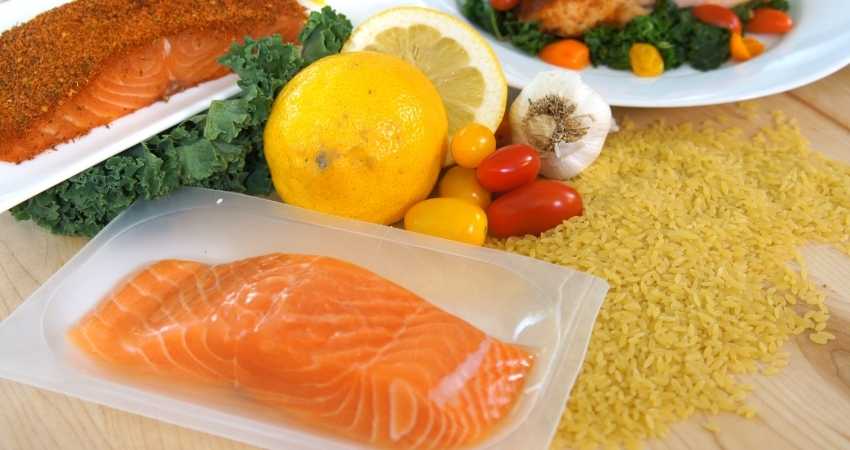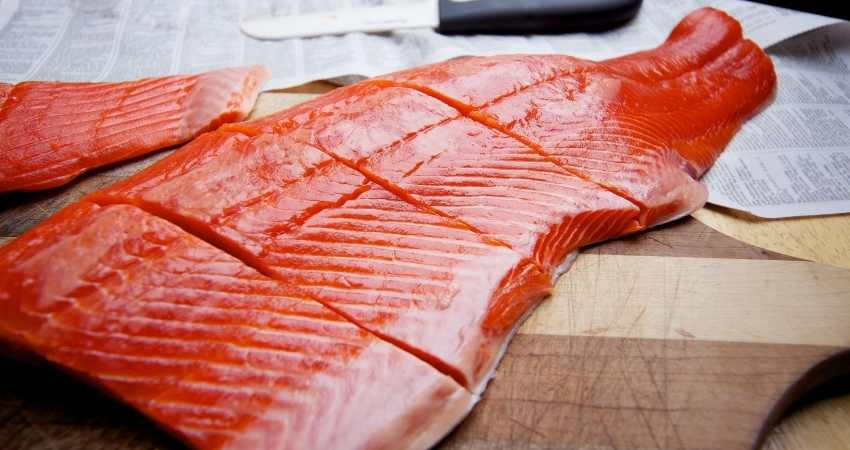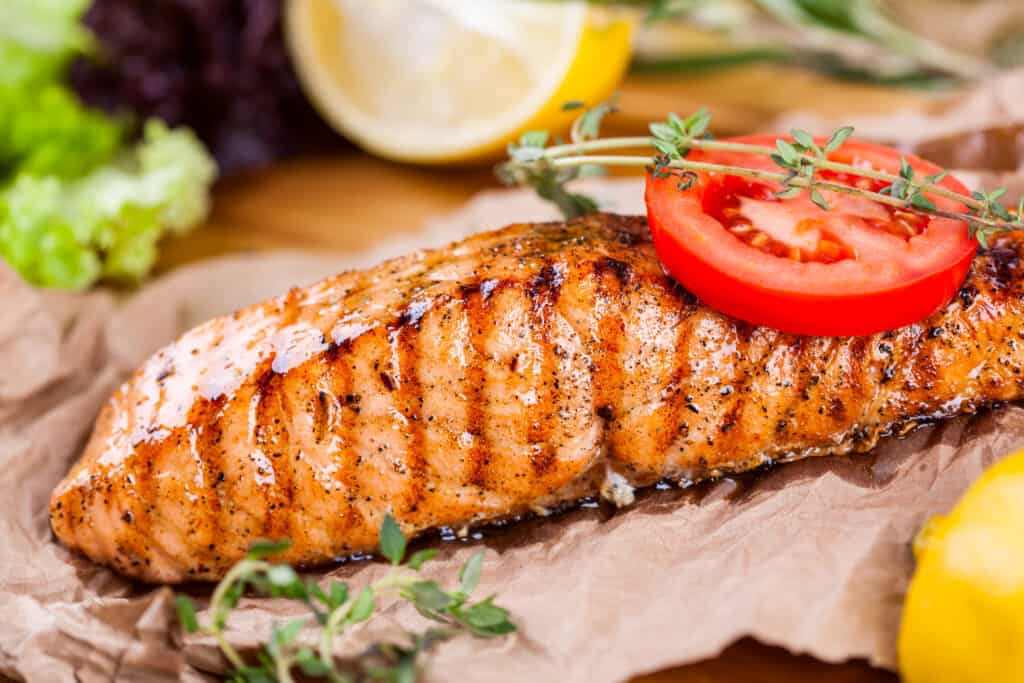Farm Raised Salmon Compared To Wild Caught Salmon
You may be tempted to buy the lowest price salmon and may have wondered about farm-raised salmon compared to wild-caught.
Farm-raised salmon is bred and controlled by salmon farmers in an enclosed environment while wild-caught salmon is caught in their natural habitat and raised with no human interference. Wild caught contains less fat and fatty acids but contains more minerals. Farm raised salmon contains more chemical contaminants than wild caught.
In the following article, we are discussing, in-depth, the differences between these two types of salmon. We are looking at everything from toxins to nutritional value and even appearance. Therefore, for everything you need to know about wild-caught salmon compared to farm-raised salmon, keep reading.
What Is Farm-Raised Salmon?

To get right into the meat of the article, we’ll need to discuss what farm-raised salmon is1. Even though the name seems pretty obvious, not many people know salmon can be farmed. So, let’s take a look.
Farm-raised salmon is salmon that has been bred within an enclosed area. They are fed processed, high protein and fat food by farmers.
The reason why salmon is farmed is it’s a much more efficient way of catching salmon. It’s easier than going out and catching it with fishing boats, nets and large crews. In addition, farm-raised salmon is a way to conserve the wild salmon population.
There are two types of ways in which salmon are farmed. The first one is the method in which farm-raised salmon could be considered as organic.
Organic Farm-Raised Salmon
Let’s briefly take a look at organic farm raised.
Organically farmed raised salmon is salmon that is raised in open catch nets. This means they are still raised in their natural habitat along with other species of fish. Organic farmed salmon are fed the same processed food non-organic farmed salmon receive.
In the United States, the USDA currently does not have an organic classification for salmon. Although one is in the future as the government has been moving toward organic classified seafood for at a decade2.
You may see some organic seafoods depending on your location. Canada and Europe have been exporting their own organic seafood already ((PBS: USDA to propose standards for organic seafood raised in U.S.)).
I’ve written a detailed article about wild caught salmon and Atlantic Salmon which you can find by clicking here, Atlantic vs Wild Salmon: Which Is Better?
Typical Farm-Raised Salmon
The traditional way of farming salmon is in enclosed bodies of water. This allows the salmon to be raised in a controlled environment. Farm raised salmon are fed processed food and not have any interaction with other species of fish3.
Farm raised salmon are bred in a more dense population due to their enclosed body of water. Some farmers have less density than others. Check the video down below of a salmon farm and how they’re raised, it’s pretty interesting to watch.
Both of these methods have their pros and their cons. Let’s move onto wild caught salmon, my personal favorite.
What Is Wild Salmon?
Wild salmon is salmon caught in a more traditional way. Typically, they catch the fish from boats using nets or fishing rods. Wild salmon is caught in its natural habitat and has been raised with no human interference. Salmon can either be caught in freshwater rivers and lakes or out in the ocean.
Wild caught salmon consume food from their natural environment and have interactions with other species of sea creatures4.
Farm-Raised Salmon Vs Wild Salmon: The Major Differences
When comparing both kinds, there are key factors to consider to make this comparison. In addition to the topics already covered like breeding, how they’re caught and food source, the following are main comparisons between farm raised salmon and wild caught.
Nutritional Value
When it comes to nutritional value, both farm-raised salmon and wild salmon have similar nutrients but there are some differences in how much they contain5. The main differences are the fatty content, essential fatty acids and minerals6
| Nutrient | Wild-Caught Raw Atlantic Salmon 1/2 Fillet (198g) |
Farm-Raised Raw Atlantic Salmon 1/2 Fillet (198g) |
| Calories | 281 | 412 |
| Calories From Fat | 113 | 240 |
| Protein | 39.3 g | 40.4 g |
| Total Fat | 12.6 g | 26.6 g |
| Saturated Fat | 1.9 g | 6.0 g |
| Omega-3 Fatty Acids | 3,996 mg | 4,961 mg |
| Omega-6 Fatty Acids | 341 mg | 1,944 mg |
| Niacin | 15.6 mg | 17.2 mg |
| Vitamin B6 | 1.6 mg | 1.3 mg |
| Folate | 49.5 mcg | 51.5 mcg |
| Vitamin B12 | 6.3 mcg | 6.4 mcg |
| Calcium | 23.8 mg | 17.8 mg |
| Iron | 1.6 mg | 0.7 mg |
| Magnesium | 57.4 mg | 53.5 mg |
| Potassium | 970 mg | 719 mg |
| Zinc | 1.3 mg | 0.7 mg |
| Selenium | 72.3 mcg | 47.5 mcg |
| Cholesterol | 109 mg | 109 mg |
Farm caught salmon has a much higher fat count than wild-caught salmon. The difference is actually pretty stark, especially the saturated fat. Farm-raised salmon can have up to 46% more calories from fat than a wild-caught salmon. Farm raised can have three times the number of saturated fats.
Farm raised salmon has slightly more omega-3 but five times more omega-67. Omega-3 is more important, studies have shown people who consume more omega-3 and less omega-6 enjoy more healthy years8.
More people already consume too much omega-6 which throws the ratio of the two out of balance9.
Wild caught salmon contains more minerals than farm raised, particularly iron, potassium and zinc.
Color

This is also another important difference between the two types of salmon. When you think of salmon, you probably visualize a light pink fish and surprisingly, farm-raised salmon does not have that pinkish tint naturally.
Wild salmon get its natural orange-red color from eating certain foods shrimp and krill in the wild. Farm-raised salmon has a light grey color artificially changed to pink by the farmer.
They must change the color because if farm raised were added to the market as a light grey, most people would not buy it. The farmers add certain colorants to the water and the salmon’s food.
Adding the color to farm raised salmon is costly as it adds approximately 20 percent more to the cost. The added expense is a must as market surveys found the darker the pink, the more people were willing to spend on the fish.
Contamination
Probably the most important thing to consider when thinking about farm-raised salmon and wild caught is the contaminants found in the salmon.
Previous studies have shown farm raised salmon contains more contaminants than wild caught10. The results differed from where the salmon was farmed. European farms were shown to have more than ones located in the United States.
Recent studies from Norway, one of the largest salmon producing countries, suggests contamination levels have changed. They claim most farms include less of the components to food which was causing the most contamination.
Some of the contaminants in salmon include:
- PCBs (polychlorinated biphenyls)
- Dioxins
- Chlorinated pesticides
- Mercury
Farm-raised salmon has a higher PCB than wild caught. PCBs may be the most serious of all the contaminants, but the FDA has deemed the levels found to be safe. Although the EPA did not ((EPA: EPA-FDA Advice about Eating Fish and Shellfish)). Some people suggest if the EPA guidelines were applied, people would eat fewer farm raised salmon.
Most of the studies show farm raised salmon contains more mercury than wild caught11. It’s important to note, the amounts of mercury and other trace metals are so low, they’re not a concern.
By the way, worms, although not a contaminant, are found in both farm and wild caught salmon. Should they be a concern? Search for my blog post on the homepage by typing, Worms In Your Farm-Raised Salmon? Facts & Myths Revealed.

Antibiotics
Farm raised salmon are more likely to get diseases or infections than wild caught. They are confined in their netted areas and have a denser population which can spread diseases easier. For this reason, farm raised salmon are treated with antibiotics to counter this problem.
In some countries, the use of antibiotics is controlled, but in other areas this has not been the case. Chile, who happens to be one of the largest producers of farmed salmon, has been using an excessive number of antibiotics and have been experiencing problems because of it.
A report published in 2018, claims Chile used 530 grams of antibiotics for every ton of salmon. The farm raised salmon there is an environment most scientists are concerned about12.
Norway, on the other hand, has reduced their antibiotic use to almost zero. They’re vaccinating the fish more than treating them with antibiotics13.
If you would rather purchase farm raised salmon but worried about the antibiotics, find out the source of all your salmon prior to choosing. Obviously, wild caught salmon are untreated.
Taste
In this section, we are going to talk a little bit about the different tastes and textures of both types of salmon. This is very difficult because the difference is there but it’s very subtle. However, let’s get into it.
Because of the higher fat count in farm-raised salmon, you might find it will have a slightly different flavor to wild-caught salmon. The biggest difference will be the texture. As you know, fat has a certain texture to it and this will be more prominent in farm-raised salmon.
The difference is very subtle, therefore, I wouldn’t say this factor is as important as some of the other factors mentioned above.
To conduct original research I set up a taste test comparison at home. I waited until I had both types of salmon. I used two pans and cooked each salmon the same exact way including seasonings and cooking time.
Four people were present and I asked each person to keep their eyes closed so they wouldn’t notice any difference in the color.
The results were split 50/50, therefore my taste test concluded each salmon tasted the same.
Is Farm Raised Salmon Bad For You: Compared To Wild Salmon?
Farm-raised salmon is not bad for you, not even when you compare it to wild-caught salmon. Both of these types of salmon do have small traces of toxins and mercury, however, this is normal with most other kinds of seafood.
It is important to note that seafood is recommended in your diet twice a week14. Salmon, with all of its nutritional properties, is one of the best seafood’s you can eat to get essential nutrients into your body.
Consuming farm raised salmon or seafood is better than not consuming any at all. If cost is not an issue, of course wild caught is the better option. Don’t forget to buy farm raised salmon from a trustworthy source.
How Can You Tell If Salmon Is Farmed Or Wild
If you’re buying pre-packaged salmon in your local supermarket, the label will contain the information. Typically a commercial brand will inform you wild caught or farm raised. If the salmon was packaged by the seafood department in the store, it would say wild caught but if it was farm raised it may not say it.
As far as looking at the salmon fish itself, there are probably two ways for you to tell whether salmon is farmed or wild caught. The first way is the most obvious. So, let’s jump straight into it.
Farm-raised salmon will have a different appearance around the face compared to wild-caught salmon. A farm-raised salmon will have a more natural and normal face. A wild-caught salmon will have a split in its lower and upper lip it gets from adapting to the wild conditions it’s in.
When it comes to the second method of determining whether a salmon is wild-caught or farmed is down to the texture. There will be a higher fat count in farm-raised salmon.
Therefore, if you’re eating the fish and the salmon feels very fatty, you’re probably eating farm-raised salmon. This difference is very subtle and harder to determine.
If you have any questions about this article don’t hesitate to comment below or email us. You can find an email on our contact page.
Read Next – More Food vs Food!
Pink vs Red Salmon: What’s The Difference?
Sardines vs Salmon: A Complete Comparison
Atlantic vs Pacific Salmon: What’s The Difference?
Frozen Salmon vs Canned Salmon: Which Is Healthier?
Sea Bass vs Salmon: Which Is Better?
Salmon vs Chicken: Which is Healthier?
- Global Salmon Initiative: About Salmon Farming [↩]
- USDA: Organic Aquaculture [↩]
- Wikipedia: Aquaculture of salmonids [↩]
- Washington State Department of Health: Farmed Salmon vs. Wild Salmon [↩]
- NutritionData: Farm raised salmon, raw [↩]
- NutritionData: Wild salmon, raw [↩]
- National Center for Biotechnology Information: Quantitative analysis of the benefits and risks of consuming farmed and wild salmon [↩]
- National Center for Biotechnology Information: Does-dependent consumption of farmed Atlantic salmon (Salmon salad) increases plasma phospholipid n-3 fatty acids differentially [↩]
- National Center for Biotechnology Information: Lipid composition and contaminants in farmed and wild salmon [↩]
- National Center for Biotechnology Information: Global assessment of organic contaminants in farmed salmon [↩]
- ScienceDirect: Preliminary examination of contaminant loadings in farmed salmon, wild salmon and commercial salmon feed [↩]
- National Center for Biotechnology Information: Current Status of the Use of Antibiotics and the Antimicrobial Resistance in the Chilean Salmon Farms [↩]
- National Center for Biotechnology Information: Contaminant levels in Norwegian farmed Atlantic salmon (Salmon salad) in the 13-year period from 1999 to 2011 [↩]
- USDA: Eat fish! Which Fish? That Fish! Go Fish! [↩]
